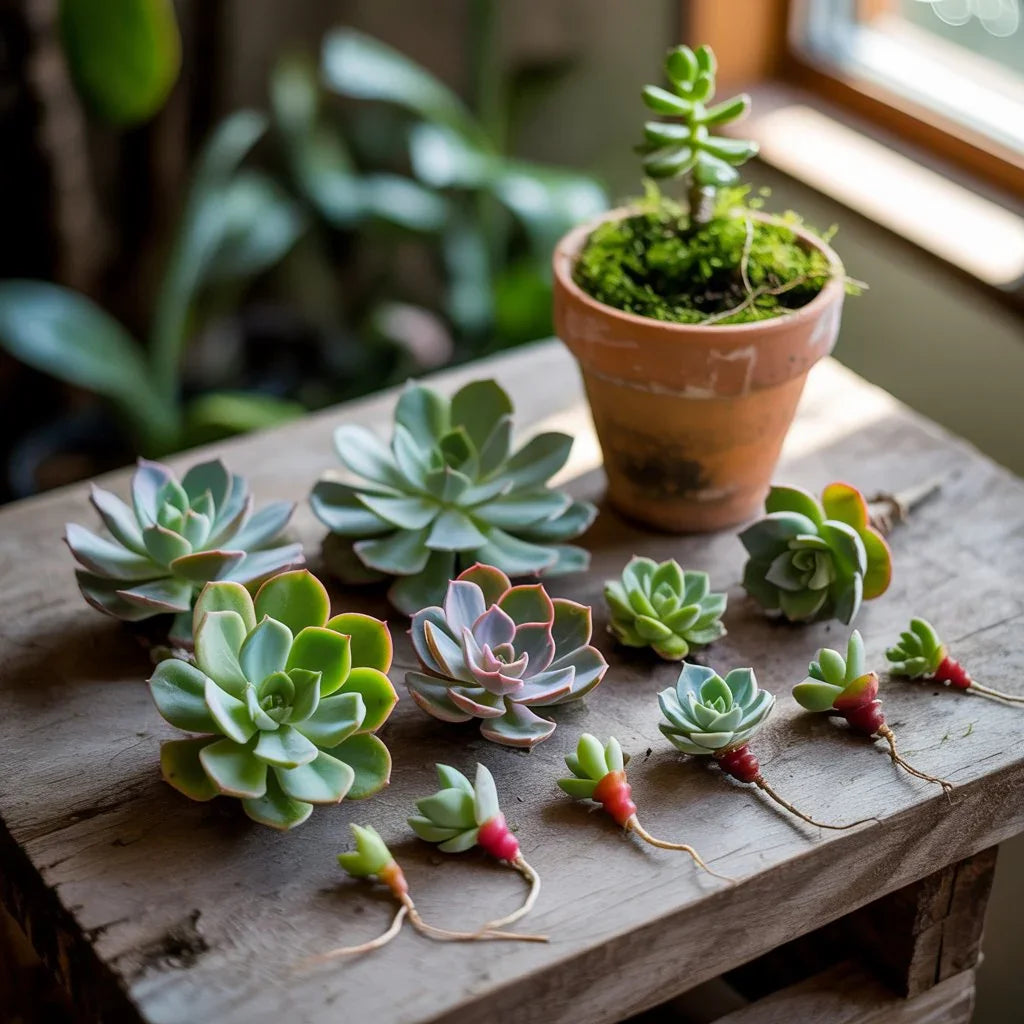
Succulent Propagation Techniques: Leaf, Stem, and Offset Methods
Share
Multiplying succulents is one of the most rewarding parts of growing them. A single plant can turn into dozens, letting you share gifts with friends, create new arrangements, or fill your home with greenery — all without buying more plants. After years of working with succulents in Manhattan, I’ve seen how propagation transforms small collections into thriving displays. This guide breaks down the three most effective methods — leaf, stem, and offsets — so you can propagate succulents with confidence and care.
What is Succulent Propagation?
Propagation is the process of creating new plants from parts of an existing one — a natural, sustainable way to grow your collection. Succulents are especially suited for propagation because of their ability to store water and nutrients in leaves and stems. This means they can survive and root even after being separated from the main plant.
Propagation by Leaves
Leaf propagation is ideal for rosette-forming succulents like echeveria or graptoveria. It’s simple and works well for beginners.
How to Propagate from Leaves (Step-by-Step)
Select a Healthy Leaf
Choose a plump, undamaged leaf from the base of the plant.
Remove Gently
Twist the leaf carefully so it detaches cleanly, without tearing.
Let It Callous
Place the leaf in a dry area for 1–2 days until the end forms a callous.
Place on Soil
Lay the leaf on top of well-draining succulent soil; do not bury it.
Mist Lightly
Mist with water every few days to maintain light moisture (not soggy).
Wait for Roots
Tiny roots and baby rosettes will appear in 2–4 weeks.
Transplant
Once the baby plant is large enough, transfer it to its own pot.
Mistakes to Avoid in Leaf Propagation
-
Overwatering (causes rot)
-
Burying the leaf (leads to suffocation)
-
Using damaged or thin leaves (low success rate)
Propagation by Stem Cuttings
Stem propagation is best for succulents with branching growth, such as jade plants, kalanchoe, or sedum.
How to Propagate from Stem Cuttings
Choose a Healthy Stem
Look for a firm, pest-free stem at least 4–6 inches long.
Make a Clean Cut
Use sterilized scissors or pruning shears to avoid infection.
Remove Lower Leaves
Leave a few inches of bare stem for planting.
Allow to Callous
Let the cutting dry for 2–3 days in a shaded area.
Plant in Soil
Insert the calloused end into a gritty soil mix.
Water Sparingly
Mist or lightly water until roots form, then follow normal care.
Pro Tip
Applying rooting hormone (optional) speeds up root development and improves success rates.
Propagation by Offsets (Pups)
Many succulents produce natural “pups” or offsets — miniature versions of themselves growing at the base. Separating pups is one of the easiest propagation methods.
How to Separate and Plant Pups
Identify Mature Pups
Look for pups with several leaves and visible roots.
Loosen Soil Around Pup
Gently lift the pup from the base of the plant.
Separate Carefully
Use clean hands or a small knife to detach without damaging roots.
Replant in New Soil
Place the pup in its own pot with succulent mix.
Water Lightly
Allow a week before watering to prevent rot.
Best Soil for Propagation
Propagation soil should be light, fast-draining, and low in organic matter. A simple mix:
-
2 parts cactus soil or light potting mix
-
1 part coarse sand
-
1 part perlite or pumice
This blend prevents root rot and mimics the natural conditions succulents prefer.
Ideal Light and Temperature for Propagation
-
Bright, indirect sunlight is best; avoid harsh midday sun.
-
Warm temperatures between 65–80°F promote faster rooting.
-
If propagating indoors during winter, supplement with grow lights.
Caring for New Succulent Babies
-
Water sparingly: Only when soil feels dry and roots are established.
-
Keep in indirect light until strong enough for brighter conditions.
-
Transplant to larger pots after 2–3 months of growth.
Creative Ways to Use Propagated Succulents
Propagation isn’t just practical; it’s creative. Use new plants for:
-
DIY succulent arrangements and terrariums
-
Eco-friendly wedding or party favors
-
Living wreaths or centerpieces for seasonal décor
-
Gifting friends and family personalized plants
Why Propagation Matters for Urban Gardeners
For city dwellers with limited space, propagation offers a cost-effective way to expand plant collections. Instead of buying new plants, you can multiply your favorites — creating endless possibilities for indoor gardens, balconies, and office décor.
Ready to Multiply Your Succulent Collection?
Propagation transforms one plant into many, turning simple care into a creative journey. Whether you’re starting with leaves, stems, or pups, the process is beginner-friendly and deeply rewarding.
Shop premium succulents and propagation-ready plants at Black Petals or visit us at 1121 1st Ave, Manhattan, for same-day pickup and expert tips.
